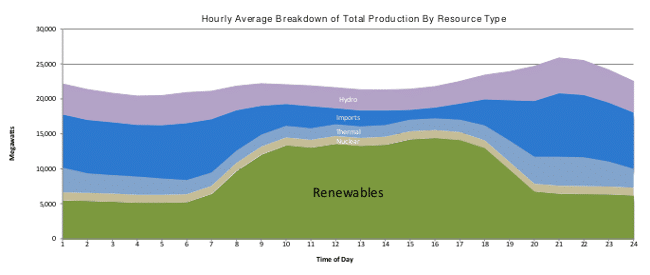In previous years, all eyes were on Europe as the leader in the Energy Transition. However, as progress has slowed in Germany and other nations, California re-emerging as a global leader. In 2016 the state met nearly a third of its electricity demand with renewable energy, including 20% with solar, wind, geothermal and other non-hydro resources.
On Saturday, California’s grid operator hit a new record, with renewable energy sources peaking at more than 2/3 of electric demand shortly before 3 PM. This follows on a week of strong wind and solar generation, with solar reaching a record output of 9.87 GW on on Thursday, followed by an all-time wind record of nearly 4.8 GW on Saturday.
Saturday May 13 did not hit a record for raw output in either solar or wind, but a combination of lower weekend demand and strong solar and wind production meant that total renewable energy generation excluding large hydro rose above 14 GW in during the afternoon, and shortly before 3 PM met 67% of all demand.
This included solar PV, which peaked at 8.7 GW ten minutes earlier, as well as concentrating solar power (CSP), which reached 494 MW around noon. The combination of these two resources and wind output pushed net power demand down to roughly 9 GW around 3 PM.
But as California reaches German levels of renewable energy penetrations it is also inheriting problems seen in Germany. Negative power prices are becoming increasingly common in the state, and according to an analysis by UtilityDive dipped below zero an average of twice daily in March.
And while negative prices are a problem for conventional generators, the state’s integration challenges are being felt by renewable energy as well. The state expects between 6 GW and 8 GW of curtailment this spring, largely due to huge volumes of hydro after an extremely wet winter.
Such curtailment was seen on May 13, and peaked at over 1.6 GW at 11 AM. There was still 800 MW of system-wide curtailment at 2 PM. This was mostly classified as “economic” curtailment, meaning that it was cheaper to curtail wind and solar than to switch off certain conventional generation.
And while faster electricity trading with other regional grids through the Electricity Imbalance Market is helping the California Independent System Operator (ISO) to integrate more solar and wind, the state’s grid does not appear to have reached maximum flexibility yet. California still has one nuclear power plant, Diablo Canyon, which continues to run 24/7 including during periods of peak wind and solar output.
More confusing is that California continues to import power, including during periods of peak renewable energy generation. California ISO charts show around 1 GW of imports even at 2-3 PM while wind and solar are being curtailed on a system-wide basis.

Diablo Canyon is currently scheduled for retirement by 2025, however the issues with negative prices and curtailment are only going to get worse in the next eight years, as California moves towards its 50% renewable energy mandate. As this excludes the 12% of the state’s electric demand met by large hydroelectric dams, it will mean very high levels of wind and solar, which in turn will require much greater flexibility in system operations.
But flexible operations of power markets are not all that will be needed. A recent analysis by Climate Policy Initiative found that the ideal mix of wind and solar for the state would be heavily tilted towards solar, and additionally found that supporting a rapid ramp-up of power in the evening when solar PV stops producing is the state’s most urgent technical need.
As such, batteries are likely to remain a key resource in California’s transition to renewable energy. A 2016 report by the U.S. Department of Energy’s National Renewable Energy Laboratories (NREL) found that even with high levels of system flexibility, 15 GW of energy storage will be needed for the state to get 50% of its electricity from solar PV while suffering only modest levels of curtailment.
This content is protected by copyright and may not be reused. If you want to cooperate with us and would like to reuse some of our content, please contact: editors@pv-magazine.com.









By submitting this form you agree to pv magazine using your data for the purposes of publishing your comment.
Your personal data will only be disclosed or otherwise transmitted to third parties for the purposes of spam filtering or if this is necessary for technical maintenance of the website. Any other transfer to third parties will not take place unless this is justified on the basis of applicable data protection regulations or if pv magazine is legally obliged to do so.
You may revoke this consent at any time with effect for the future, in which case your personal data will be deleted immediately. Otherwise, your data will be deleted if pv magazine has processed your request or the purpose of data storage is fulfilled.
Further information on data privacy can be found in our Data Protection Policy.